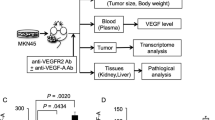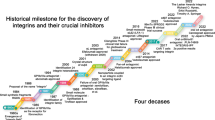Abstract
Inhibitors of αvβ3 and αvβ5 integrin have entered clinical trials as antiangiogenic agents for cancer treatment but generally have been unsuccessful. Here we present in vivo evidence that low (nanomolar) concentrations of RGD-mimetic αvβ3 and αvβ5 inhibitors can paradoxically stimulate tumor growth and tumor angiogenesis. We show that low concentrations of these inhibitors promote VEGF-mediated angiogenesis by altering αvβ3 integrin and vascular endothelial growth factor receptor-2 trafficking, thereby promoting endothelial cell migration to VEGF. The proangiogenic effects of low concentrations of RGD-mimetic integrin inhibitors could compromise their efficacy as anticancer agents and have major implications for the use of RGD-mimetic compounds in humans.
This is a preview of subscription content, access via your institution
Access options
Subscribe to this journal
Receive 12 print issues and online access
$209.00 per year
only $17.42 per issue
Buy this article
- Purchase on Springer Link
- Instant access to full article PDF
Prices may be subject to local taxes which are calculated during checkout






Similar content being viewed by others
References
Kerbel, R. & Folkman, J. Clinical translation of angiogenesis inhibitors. Nat. Rev. Cancer 2, 727–739 (2002).
Ellis, L.M. & Hicklin, D.J. VEGF-targeted therapy: mechanisms of anti-tumour activity. Nat. Rev. Cancer 8, 579–591 (2008).
Ferrara, N., Hillan, K.J., Gerber, H.P. & Novotny, W. Discovery and development of bevacizumab, an anti-VEGF antibody for treating cancer. Nat. Rev. Drug Discov. 3, 391–400 (2004).
Olsson, A.K., Dimberg, A., Kreuger, J. & Claesson-Welsh, L. VEGF receptor signalling—in control of vascular function. Nat. Rev. Mol. Cell Biol. 7, 359–371 (2006).
Neufeld, G., Cohen, T., Gengrinovitch, S. & Poltorak, Z. Vascular endothelial growth factor (VEGF) and its receptors. FASEB J. 13, 9–22 (1999).
Hurwitz, H. et al. Bevacizumab plus irinotecan, fluorouracil and leucovorin for metastatic colorectal cancer. N. Engl. J. Med. 350, 2335–2342 (2004).
Sandler, A. et al. Paclitaxel-carboplatin alone or with bevacizumab for non–small-cell lung cancer. N. Engl. J. Med. 355, 2542–2550 (2006).
Miller, K. et al. Paclitaxel plus bevacizumab versus paclitaxel alone for metastatic breast cancer. N. Engl. J. Med. 357, 2666–2676 (2007).
Motzer, R.J. et al. Sunitinib versus interferon α in metastatic renal-cell carcinoma. N. Engl. J. Med. 356, 115–124 (2007).
Varner, J.A. & Cheresh, D.A. Integrins and cancer. Curr. Opin. Cell Biol. 8, 724–730 (1996).
Hodivala-Dilke, K.M., Reynolds, A.R. & Reynolds, L.E. Integrins in angiogenesis: multitalented molecules in a balancing act. Cell Tissue Res. 314, 131–144 (2003).
Mitjans, F. et al. In vivo therapy of malignant melanoma by means of antagonists of αv integrins. Int. J. Cancer 87, 716–723 (2000).
Buerkle, M.A. et al. Inhibition of the αv integrins with a cyclic RGD peptide impairs angiogenesis, growth and metastasis of solid tumours in vivo. Br. J. Cancer 86, 788–795 (2002).
MacDonald, T.J. et al. Preferential susceptibility of brain tumors to the antiangiogenic effects of an αv integrin antagonist. Neurosurgery 48, 151–157 (2001).
Tucker, G.C. Integrins: molecular targets in cancer therapy. Curr. Oncol. Rep. 8, 96–103 (2006).
Stupp, R. & Ruegg, C. Integrin inhibitors reaching the clinic. J. Clin. Oncol. 25, 1637–1638 (2007).
Brooks, P.C., Clark, R.A. & Cheresh, D.A. Requirement of vascular integrin αvβ3 for angiogenesis. Science 264, 569–571 (1994).
Brooks, P.C. et al. Integrin αvβ3 antagonists promote tumor regression by inducing apoptosis of angiogenic blood vessels. Cell 79, 1157–1164 (1994).
Brooks, P.C. et al. Antiintegrin αvβ3 blocks human breast cancer growth and angiogenesis in human skin. J. Clin. Invest. 96, 1815–1822 (1995).
Tucker, G.C. αv integrin inhibitors and cancer therapy. Curr. Opin. Investig. Drugs 4, 722–731 (2003).
Dechantsreiter, M.A. et al. N-Methylated cyclic RGD peptides as highly active and selective αVβ3 integrin antagonists. J. Med. Chem. 42, 3033–3040 (1999).
Nisato, R.E., Tille, J.C., Jonczyk, A., Goodman, S.L. & Pepper, M.S. αvβ3 and αvβ5 integrin antagonists inhibit angiogenesis in vitro. Angiogenesis 6, 105–119 (2003).
Perron-Sierra, F. et al. Substituted benzocyloheptenes as potent and selective αv integrin antagonists. Bioorg. Med. Chem. Lett. 12, 3291–3296 (2002).
Maubant, S. et al. Blockade of αvβ3 and αvβ5 integrins by RGD mimetics induces anoikis and not integrin-mediated death in human endothelial cells. Blood 108, 3035–3044 (2006).
Nabors, L.B. et al. Phase I and correlative biology study of cilengitide in patients with recurrent malignant glioma. J. Clin. Oncol. 25, 1651–1657 (2007).
Eskens, F.A. et al. Phase I and pharmacokinetic study of continuous twice weekly intravenous administration of Cilengitide (EMD 121974), a novel inhibitor of the integrins αvβ3 and αvβ5 in patients with advanced solid tumours. Eur. J. Cancer 39, 917–926 (2003).
Friess, H. et al. A randomized multi-center phase II trial of the angiogenesis inhibitor cilengitide (EMD 121974) and gemcitabine compared with gemcitabine alone in advanced unresectable pancreatic cancer. BMC Cancer 6, 285 (2006).
Hariharan, S. et al. Assessment of the biological and pharmacological effects of the αvβ3 and αvβ5 integrin receptor antagonist, cilengitide (EMD 121974), in patients with advanced solid tumors. Ann. Oncol. 18, 1400–1407 (2007).
Chatterjee, S., Matsumura, A., Schradermeier, J. & Gillespie, G.Y. Human malignant glioma therapy using anti-αvβ3 integrin agents. J. Neurooncol. 46, 135–144 (2000).
Taga, T. αv-integrin antagonist EMD 121974 induces apoptosis in brain tumor cells growing on vitronectin and tenascin. Int. J. Cancer 98, 690–697 (2002).
Legler, D.F., Wiedle, G., Ross, F.P. & Imhof, B.A. Superactivation of integrin αvβ3 by low antagonist concentrations. J. Cell Sci. 114, 1545–1553 (2001).
Prewett, M. et al. Antivascular endothelial growth factor receptor (fetal liver kinase 1) monoclonal antibody inhibits tumor angiogenesis and growth of several mouse and human tumors. Cancer Res. 59, 5209–5218 (1999).
Reynolds, A.R. et al. Elevated Flk1 (vascular endothelial growth factor receptor 2) signaling mediates enhanced angiogenesis in β3-integrin–deficient mice. Cancer Res. 64, 8643–8650 (2004).
Duval, M., Bedard-Goulet, S., Delisle, C. & Gratton, J.P. Vascular endothelial growth factor–dependent down-regulation of Flk-1/KDR involves Cbl-mediated ubiquitination. Consequences on nitric oxide production from endothelial cells. J. Biol. Chem. 278, 20091–20097 (2003).
Ewan, L.C. et al. Intrinsic tyrosine kinase activity is required for vascular endothelial growth factor receptor 2 ubiquitination, sorting and degradation in endothelial cells. Traffic 7, 1270–1282 (2006).
Lampugnani, M.G., Orsenigo, F., Gagliani, M.C., Tacchetti, C. & Dejana, E. Vascular endothelial cadherin controls VEGFR-2 internalization and signaling from intracellular compartments. J. Cell Biol. 174, 593–604 (2006).
Gampel, A. et al. VEGF regulates the mobilization of VEGFR2/KDR from an intracellular endothelial storage compartment. Blood 108, 2624–2631 (2006).
Roberts, M., Barry, S., Woods, A., van der Sluijs, P. & Norman, J. PDGF-regulated rab4-dependent recycling of αvβ3 integrin from early endosomes is necessary for cell adhesion and spreading. Curr. Biol. 11, 1392–1402 (2001).
Caswell, P. & Norman, J. Endocytic transport of integrins during cell migration and invasion. Trends Cell Biol. 18, 257–263 (2008).
Mahabeleshwar, G.H., Feng, W., Phillips, D.R. & Byzova, T.V. Integrin signaling is critical for pathological angiogenesis. J. Exp. Med. 203, 2495–2507 (2006).
Reynolds, L.E. et al. Enhanced pathological angiogenesis in mice lacking β3 integrin or β3 and β5 integrins. Nat. Med. 8, 27–34 (2002).
Hynes, R.O. A reevaluation of integrins as regulators of angiogenesis. Nat. Med. 8, 918–921 (2002).
Hodivala-Dilke, K. αvβ3 integrin and angiogenesis: a moody integrin in a changing environment. Curr. Opin. Cell. Biol. 20, 514–519 (2008).
Calabrese, E.J. Cancer biology and hormesis: human tumor cell lines commonly display hormetic (biphasic) dose responses. Crit. Rev. Toxicol. 35, 463–582 (2005).
Bretscher, M.S. Moving membrane up to the front of migrating cells. Cell 85, 465–467 (1996).
Bailly, M. et al. Epidermal growth factor receptor distribution during chemotactic responses. Mol. Biol. Cell 11, 3873–3883 (2000).
Fan, G.H., Lapierre, L.A., Goldenring, J.R., Sai, J. & Richmond, A. Rab11-family interacting protein 2 and myosin Vb are required for CXCR2 recycling and receptor-mediated chemotaxis. Mol. Biol. Cell 15, 2456–2469 (2004).
Jekely, G., Sung, H.H., Luque, C.M. & Rorth, P. Regulators of endocytosis maintain localized receptor tyrosine kinase signaling in guided migration. Dev. Cell 9, 197–207 (2005).
Caswell, P.T. et al. Rab-coupling protein coordinates recycling of α5β1 integrin and EGFR1 to promote cell migration in 3D microenvironments. J. Cell Biol. 183, 143–155 (2008).
Haubner, R. et al. Noninvasive imaging of αvβ3 integrin expression using 18F-labeled RGD-containing glycopeptide and positron emission tomography. Cancer Res. 61, 1781–1785 (2001).
Chen, X., Conti, P.S. & Moats, R.A. In vivo near-infrared fluorescence imaging of integrin αvβ3 in brain tumor xenografts. Cancer Res. 64, 8009–8014 (2004).
Danen, E.H., Sonneveld, P., Brakebusch, C., Fassler, R. & Sonnenberg, A. The fibronectin-binding integrins α5β1 and αvβ3 differentially modulate RhoA-GTP loading, organization of cell matrix adhesions, and fibronectin fibrillogenesis. J. Cell Biol. 159, 1071–1086 (2002).
Dormond, O., Ponsonnet, L., Hasmim, M., Foletti, A. & Ruegg, C. Manganese-induced integrin affinity maturation promotes recruitment of αVβ3 integrin to focal adhesions in endothelial cells: evidence for a role of phosphatidylinositol 3-kinase and Src. Thromb. Haemost. 92, 151–161 (2004).
Acknowledgements
We would like to thank S. Goodman (Merck KGaA) for the gift of the cilengitide; P. Casara (Institut de Recherches Servier) for the synthesis of S 36578; D. Hicklin (Imclone Systems Incorporated) for the gift of the DC101 antibody; M. Marsh (University College London) for the gift of the CD63-specific antibody; P. Newman (Medical College of Wisconsin) for the gift of the AP5 antibody; A. Mustafa and the staff of the Biological Services Units at Queen Mary University of London and Cancer Research UK for their assistance with animal experiments; G. Elia and the staff of the Histopathology Unit at Cancer Research UK for the preparation of tissue sections; G. D'Amico Lago, P. Caswell, C. Junges and M. Bertrand for assistance with experiments; and B. Imhof, J. Hickman and S. Kermorgant for useful discussions and critical comments on the manuscript. A.R.R. was funded by a Post-Doctoral Fellowship from Cancer Research UK, a Post-Doctoral Fellowship from the Barts and the Royal London Charitable Foundation (RAB04/F2) and a Senior Fellowship from Breakthrough Breast Cancer. J.C.W. and M.G. were supported by Breakthrough Breast Cancer, R.G.S. was a student of the Third Gulbenkian PhD Programme in Biomedicine and was sponsored by the Portuguese Foundation for Science and Technology (SFRH/BD/1/) 2003. I.R.H., A.R.W., D.T.J., M.C.J., S.D.R., V.K., G.S., J.C.N. and K.M.H.-D. are funded by Cancer Research UK.
Author information
Authors and Affiliations
Contributions
A.R.R. conceived of and designed the study, performed the majority of the experiments and co-wrote the manuscript; I.R.H. assisted with in vivo experiments and provided comments on the manuscript; A.R.W., R.G.S., V.K. and G.S. assisted with in vivo experiments; J.C.W., S.D.R. and D.T.J. assisted with quantitative PCR and angiogenesis assays; G.D.V. made measurements on plasma samples; M.G. and M.C.J. assisted with in vitro biochemical assays; M.S. performed the analysis of VEGFR2 staining, F.P.-S. synthesized S 36578; J.C.N. designed and performed some of the receptor trafficking experiments and helped with data interpretation; G.C.T. assisted with the study design and provided vital research reagents; and K.M.H.-D. supervised the research and co-wrote the manuscript.
Corresponding authors
Supplementary information
Supplementary Text and Figures
Supplementary Figs. 1–9 and Supplementary Methods (PDF 1574 kb)
Rights and permissions
About this article
Cite this article
Reynolds, A., Hart, I., Watson, A. et al. Stimulation of tumor growth and angiogenesis by low concentrations of RGD-mimetic integrin inhibitors. Nat Med 15, 392–400 (2009). https://doi.org/10.1038/nm.1941
Received:
Accepted:
Published:
Issue Date:
DOI: https://doi.org/10.1038/nm.1941
This article is cited by
-
Therapy-induced modulation of tumor vasculature and oxygenation in a murine glioblastoma model quantified by deep learning-based feature extraction
Scientific Reports (2024)
-
Emerging therapeutic opportunities for integrin inhibitors
Nature Reviews Drug Discovery (2022)
-
Inhibition of angiogenesis and tumor progression of MK-0429, an integrin αvβ3 antagonist, on oral squamous cell carcinoma
Journal of Cancer Research and Clinical Oncology (2022)
-
The endosomal RIN2/Rab5C machinery prevents VEGFR2 degradation to control gene expression and tip cell identity during angiogenesis
Angiogenesis (2021)
-
Assessment of a pro-healing stent in an animal model of early neoatherosclerosis
Scientific Reports (2020)



